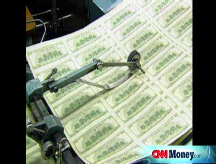Bonds' 4% solution
The yield on the benchmark 10-year note is at its highest level since January, and experts believe long-term rates will climb even more.

 |
| The yield on the widely watched U.S. 10-year Treasury is back above 4% for the first time in months. Some think it may head as high as 4.5% by the end of the year. |
NEW YORK (CNNMoney.com) -- The magic number for the bond market is 4, as in the yield on the U.S. 10-year Treasury note. And for the first time since January, the 10-year yield is above 4%
The yield hit 4% yesterday. And as of Thursday afternoon, it was at 4.09%
I wrote about how investors were bailing on Treasurys a few weeks ago. At the time the yield on the 10-year was hovering around 3.85% and several of my fixed-income sources were telling me that they thought a 4% yield was coming sooner rather than later.
So what's next for the 10-year? And what does this recent sell-off in Treasurys mean for the markets and economy? (Quick Bond 101 refresher: bond prices and yields move in opposite directions.)
Jonathan Smith, chief investment officer of fixed income for Haverford, a money manager with $6 billion in assets under management, said the move is a sign that investors are starting to feel more comfortable shifting to more risky assets, such as stocks and corporate debt.
He said rates were as low as they were earlier this year - the 10-year yield sunk to as low as 3.29% in March - because there was a perception that they were the only safe investment out there. That's no longer the case.
"The main thing bond investors are signaling is the fact that Treasurys are overvalued. You had a significant flight to quality in 2007 and early 2008 culminating with the Bear Stearns debacle," Smith said. "Treasurys were the only thing in demand. Now we're getting back to normalcy."
Steve Van Order, chief fixed income strategist with Calvert Funds, which manages about $10 billion in bond assets, agrees.
"The flight to quality is gone. The bull cycle for Treasurys is over," he said.
Van Order added that he thinks the 10-year could wind up hitting 4.25% in the next few months. He also said that the yield on the 2-year Treasury, currently at 2.75%, could settle in around 3%.
Why is this the case? Simply put, investors are starting to grow more worried about inflation than an economic slowdown. Higher bond yields are usually associated with times of rising pricing pressures. And we certainly are living in that environment now, with gas nearing $4 a gallon nationwide and food prices soaring.
Along those lines, Matthew Smith, portfolio manager Smith Affiliated Capital, a money management firm with $2.2 billion in assets, said the price of oil will probably have the most impact on bond yields in the near term.
Interestingly though, he thinks that since bond rates were so low earlier this year, fixed-income investors might continue to sell Treasurys even if oil prices and inflation fears ebb. That's because he thinks lower oil prices will lead more investors to the conclusion that equities are a better investment.
"Oil is now a double-edged sword. When prices go up it's inflationary, and bonds sell off. But if oil prices come down from here, people may think there will be better growth prospects in stocks and that there's no reason to be in Treasurys anymore," he said.
Still, Van Order said the minutes from the Federal Reserve's last meeting in April were a clear indication the the central bank is growing more worried about inflation than a severe recession.
As such, many market experts now expect the Fed to keep its key federal funds rate at 2% for the next few months. Some even think the Fed may be forced to raise rates by the end of the year to combat inflation. And that would likely lead to higher long-term bond yields.
"The latest economic data is not good but it's not horrendous. The Fed is out of the picture for awhile. We won't get further rate cuts," Van Order said.
But don't expect long-term rates to move dramatically higher. Haverford's Smith thinks the Fed still is on recession watch.
Even though the Fed's seven rate cuts since September and series of loans to banks and investment banks may help the credit crisis on Wall Street from getting much worse, Smith said the housing market is still not showing any signs of improvement.
And until that happens, Smith thinks the most likely scenario for the 10-year is that yields will hover between 4% and 4.5% for the remainder of the year.
"We have a tremendous battle going on right now between inflationary expectations and a real growth slowdown," he said. "The Fed has to be worried about both in a significant way. To me both risks are equal right now."
Issue #1 - America's Money: All this week at noon ET, CNN explains how the weakening economy affects you. Full coverage.
Gas prices have climbed to record levels. Are you feeling the pinch? Tell us how gas prices are affecting you and what you're doing to cope. Send us your photos and videos, or email us and tell us what you think. ![]()



